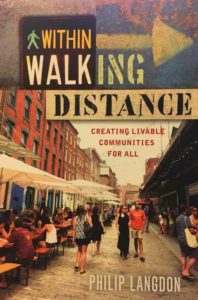Reading: Within Walking Distance: Creating Livable Communities For All by Philip Langdon
 Last week I received a new book that immediately caught my attention. Within Walking Distance: Creating Livable Communities For All speaks to a core personal issue for me — walkability. Before the personal automobile displaced public transit, most everything in American cities was within walking distance. For nearly a century now Euclidean, AKA single-use, zoning has actively created places that are well beyond walking distance.
Last week I received a new book that immediately caught my attention. Within Walking Distance: Creating Livable Communities For All speaks to a core personal issue for me — walkability. Before the personal automobile displaced public transit, most everything in American cities was within walking distance. For nearly a century now Euclidean, AKA single-use, zoning has actively created places that are well beyond walking distance.
I’m not alone in seeking out walkable places:
For five thousand years, human settlements were nearly always compact places. Everything a person needed on a regular basis lay within walking distance. But then the great project of the twentieth century—sorting people, businesses, and activities into separate zones, scattered across vast metropolises—took hold, exacting its toll on human health, natural resources, and the climate. Living where things were beyond walking distance ultimately became, for many people, a recipe for frustration. As a result, many Americans have begun seeking compact, walkable communities or looking for ways to make their current neighborhood better connected, more self-sufficient, and more pleasurable.
In Within Walking Distance, journalist and urban critic Philip Langdon looks at why and how Americans are shifting toward a more human-scale way of building and living. He shows how people are creating, improving, and caring for walkable communities. There is no one-size-fits-all approach. Starting conditions differ radically, as do the attitudes and interests of residents. To draw the most important lessons, Langdon spent time in six communities that differ in size, history, wealth, diversity, and education, yet share crucial traits: compactness, a mix of uses and activities, and human scale. The six are Center City Philadelphia; the East Rock section of New Haven, Connecticut; Brattleboro, Vermont; the Little Village section of Chicago; the Pearl District in Portland, Oregon; and the Cotton District in Starkville, Mississippi. In these communities, Langdon examines safe, comfortable streets; sociable sidewalks; how buildings connect to the public realm; bicycling; public transportation; and incorporation of nature and parks into city or town life. In all these varied settings, he pays special attention to a vital ingredient: local commitment.
To improve conditions and opportunities for everyone, Langdon argues that places where the best of life is within walking distance ought to be at the core of our thinking. This book is for anyone who wants to understand what can be done to build, rebuild, or improve a community while retaining the things that make it distinctive. (Island Press)
I’ve visited Portland’s Perl District and Philadelphia’s Center City, in July we’ll go to Chicago’s Little Village. Learning from other places is one of the smartest ways to get the inspiration to tackle neighborhoods that have great potential.
Within Walking Distance: Creating Livable Communities For All by Philip Langdon, releasing next month, is available via Island Press, Left Bank Books, and Amazon.
— Steve Patterson